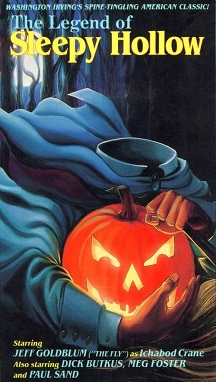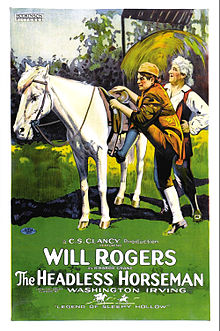
Sleepy Hollow is a 1999 gothic supernatural horror film directed by Tim Burton. It is a film adaptation loosely based on Washington Irving's 1820 short story "The Legend of Sleepy Hollow", and stars Johnny Depp and Christina Ricci, with Miranda Richardson, Michael Gambon, Casper Van Dien, Christopher Lee and Jeffrey Jones in supporting roles. The plot follows police constable Ichabod Crane (Depp) sent from New York City to investigate a series of murders in the village of Sleepy Hollow by a mysterious Headless Horseman.

"The Legend of Sleepy Hollow" is an 1820 short story by American author Washington Irving, contained in his collection of 34 essays and short stories titled The Sketch Book of Geoffrey Crayon, Gent. Irving wrote the story while living in Birmingham, England.
This is an overview of 1922 in film, including significant events, a list of films released and notable births and deaths.
The year 1916 in film involved some significant events.
The year 1915 in film involved some significant events.
1913 was a particularly fruitful year for film as an art form, and is often cited one of the years in the decade which contributed to the medium the most, along with 1917. The year was one where filmmakers of several countries made great artistic advancements, producing notable pioneering masterpieces such as The Student of Prague, Suspense, Atlantis, Raja Harischandra, Juve contre Fantomas, Quo Vadis?, Ingeborg Holm, The Mothering Heart, Ma l’amor mio non muore!, L’enfant de Paris and Twilight of a Woman's Soul.
The year 1912 in film involved some significant events.
The year 1911 in film involved some significant events.
The year 1910 in film involved some significant events.

Ichabod Crane is a fictional character and the protagonist in Washington Irving's short story "The Legend of Sleepy Hollow". Crane is portrayed in the original work, and in most adaptations, as a tall, lanky individual. He is the local schoolmaster, and strongly believes in all things supernatural, including the legend of the Headless Horseman. Crane eventually tries unsuccessfully to court the heiress Katrina Van Tassel, a decision that angers Abraham "Brom Bones" Van Brunt, a local man who also wishes to marry Katrina. After supposedly proposing to Katrina, Crane is on his way home alone at night when the Headless Horseman appears and chases the schoolmaster. The Horseman eventually throws his pumpkin head at Crane, causing him to mysteriously disappear without a trace.
L'Homme qui vendit son âme au diable is a 1921 French silent film comedy directed by Pierre Caron. The plot was similar to Faust and The Student of Prague, about a man who makes a diabolical deal with the Devil.
The Other Person is a 1921 Dutch-British silent mystery film directed by Maurits Binger and B.E. Doxat-Pratt. It was a co-production between a Dutch film company and a British film company.
Esmeralda is a 1922 British silent film and an adaptation of the 1831 novel The Hunchback of Notre-Dame by Victor Hugo, with more emphasis on the character on Esmeralda rather than Quasimodo. It was directed by Edwin J. Collins and starred Sybil Thorndike as Esmeralda and Booth Conway as the hunchback. The film is considered lost, but extant still photos show a 40-year-old Thorndike who appears to be too old for the role of the young and virginal Esmeralda. This version emphasized romance and melodrama over horror.
Harry Agar Lyons was an Irish-born British actor. He was born in Cork, Ireland in 1878 and died in Wandsworth, London, England in 1944 at age 72.

The Headless Horseman is an archetype of mythical figure that has appeared in folklore around Europe since the Middle Ages. The figures are traditionally depicted as riders upon horseback who are missing their heads. These myths have since inspired a number of stories and characters in popular culture, including The Legend of Sleepy Hollow.

Carl Alwin Heinrich Neuß was a German film director and actor, noted for playing Sherlock Holmes in a series of silent films during the 1910s. He also played the dual role of Jekyll and Hyde in the 1910 Danish silent film version of Dr. Jekyll and Mr. Hyde, directed by August Blom. He played Jekyll and Hyde again in the 1914 German silent film Ein Seltsamer Fall, scripted by Richard Oswald.

The Legend of Sleepy Hollow is a 1980 American made-for-television film produced by Sunn Classic Pictures as a part of their Classics Illustrated series. It was filmed partly in Park City, Utah and shown on NBC. It starred Jeff Goldblum as Ichabod Crane, Meg Foster as Katrina von Tassel, and Dick Butkus as Brom Bones. It was directed by Henning Schellerup and produced by Charles Sellier, who was nominated for an Emmy Award for his work on the movie.

One Glorious Day is a lost 1922 American silent fantasy comedy film directed by James Cruze and written by Barry Barringer and Walter Woods. The film stars Will Rogers, Lila Lee, Alan Hale, Sr., Johnny Fox, George Nichols, and Emily Rait. It was released on January 29, 1922, by Paramount Pictures. Working titles included Ek, A Fighting Soul and Souls Before Birth. Forrest J. Ackerman, the publisher of Famous Monsters of Filmland magazine, credited this film as being the one that "created his lifelong interest in science fiction and horror".
The Lost Shadow is a 1921 German silent film directed by Rochus Gliese and starring Paul Wegener, Wilhelm Bendow and Adele Sandrock. The cinematographer was Karl Freund. The film's sets were designed by the art director Kurt Richter. It was shot at the Tempelhof Studios in Berlin. For some reason, the film was only released in the US in 1928. It is today considered a lost film.
The Headless Horseman is a 1934 animated short film directed by Ub Iwerks and part of the ComiColor cartoon series. It is based on the 1820 short story "The Legend of Sleepy Hollow" by Washington Irving.








